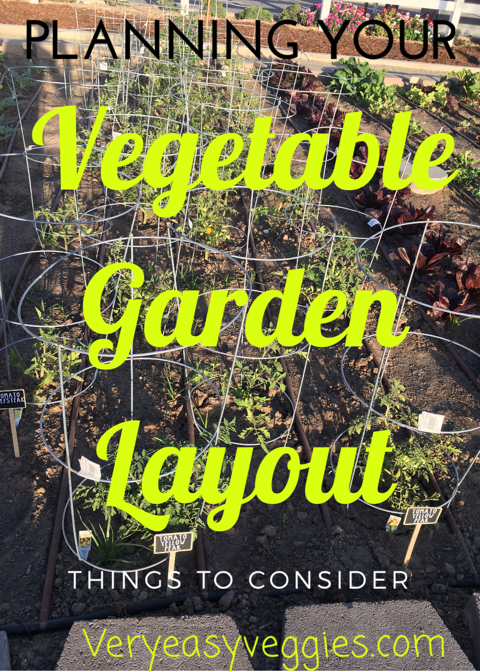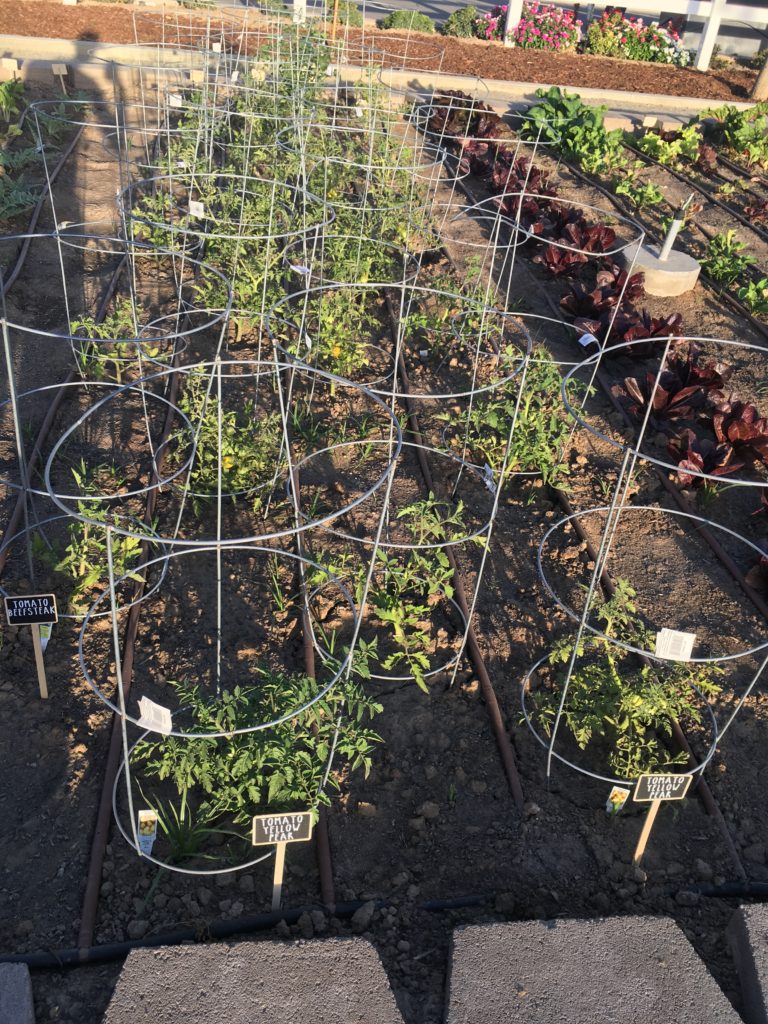One of the first steps to planning your garden is to decide what type of garden you will have, where to put it, and what you will plant. But once you’ve decided, here’s what to consider when planning your vegetable garden layout.
This page contains affiliate links to help support this blog and help you.
No time to read it all now? Grab my eBook for all these easy beginner tips and many more, from seed to harvest!
get the Very Easy Veggie Garden eBookHow many of each plant?
To answer this question, you should consider two things: how much you plan to eat (or preserve) and how much each plant usually produces.
Squash (zucchini/courgette) plants, for example, tend to produce a lot if they’re growing well. They also don’t always freeze as well, in my opinion. So if you’ll only use one or two per week, you probably don’t need six plants. Your neighbors won’t mind the extra Zucchini Bread though! (And actually, my zucchini bread recipe freezes very well).
How much will your household use? How much will each plant produce? A couple tomato plants or squash plants will probably give you at least 2-5 pieces of “fruit” per week if they do well. (If they don’t produce well, find out why here.)
Do you have a plan and some time to preserve what’s left over? I will always plant about as many tomatoes as I can since they preserve well. (Here’s a quick tutorial on preserving them). I can freeze or can them pretty quickly and they still taste great months later.

Once you know what you’re planting and how much, it’s time to map out your garden. A few things to consider:
How far apart?
Many seed packets or other label instructions will give you an exact measurement for spacing, but the truth is that this isn’t always the end-all-be-all. Depending on your method, you may actually be able to plant closer. One of my favorite things about raised bed gardening is that, if you choose good soil, you can plant things closer together as long as each plant has enough room to grow without overcrowding.
“Square Foot Gardening” has a good reference chart to help you decide how close to plant each type of vegetable in a raised bed… get a glimpse of that here.
The primary considerations for spacing your vegetables are:
- plant size–larger plants obviously need much more space, but small ones or climbing ones can be planted closer together.
- root competition for water or nutrients–providing good soil and/or fertilizer and enough water helps prevent this
- enough sunlight, & airflow to prevent disease
- your ability to access them for picking (this is why you shouldn’t make beds too wide!)
“Square Foot Gardening” has a good reference chart to help you decide how close to plant each type of vegetable in a raised bed… get a glimpse of that here. Below is a cool little gadget based off of square foot gardening to help you space your seeds or plants perfectly in your garden layout.

How will you water?
This is such an important question that many people forget to consider…. Including myself, sometimes! It’s easy to get carried away planning the layout of your garden beds and rows, only to realize later in the season that watering is a challenge.
First, you must think about your irrigation method. Perhaps you’re planning on using a simple hose (if so, make sure you’re close enough to a water spigot). However, I think it’s always smart to have the option of automating your watering system–what happens when you go out of town, get sick or busy, or forget to turn off the hose? Maybe this is mostly a dry climate problem, but either way, a regular watering system will keep your plants healthiest.
I like to automate my watering system to save time–read how here. Hose timers like the ones below are awesome, in my opinion, especially when connected to a soaker hose (my favorite type is below) for perfect watering. Many gardeners use drip irrigation, but a soaker hose is quicker to set up and easier to adjust as needed throughout the season.
Where to put what?
Invasive plants
I am adding this important note for the sudden surge of first-time-ever food growers out there–some fruit and veggie plants are invasive! This means that if you plant something like berries or mint in the same bed with other plants, it is very likely to spread and take over everything else!
Strawberries will spread across the ground by special stems called runners, so it’s best to give them their own space or plan on cutting runners and pulling out any new plants that grow. Raspberries and blackberries are even harder to control because they spread underground up to several feet! keep them very well separated from the rest of your veggie patch. Mint also spreads quickly underground, many gardeners prefer to keep it in pots or contained in some other way.
Lighting and shade
Consider that bigger and taller plants may shade the ones around it when you design your vegetable garden layout. (This is also one of the primary concerns for spacing). Each plant (aside from herbs, leafy greens, cool season veggies, and those that don’t actually “fruit”) still needs at least 6-8 hours of sun.
For instance, if you plant corn or tomatoes next to squash, cucumber, or beans, make sure that the smaller plants won’t be shaded by the taller ones! For me in California, the sun dips towards the south in its arc, so I would try to keep my tallest plants on the north side of the bed layout (if the beds run east-west lengthwise).
Some plants like a little shade to keep them cool, though. Cool-season-veggies like lettuce, broccoli, cauliflower, spinach, peas, carrots & root veggies do well in partial shade. Warm-season crops like tomatoes, squash, beans, cucumbers, melons, peppers, pumpkins, corn & okra need full sun (6-8 hours).

Friends & Enemies
Ever heard of companion planting? To be honest, I think some of it is a bit over-rated. It’s worth skimming a companion planting chart to see what veggies grow best together, but honestly I don’t spend too much time on it when planning my garden layout. Companion planting has some benefits for sure, especially certain plants, but I think some are exaggerated or made up. Marigolds helping ward off tomato worms, sure, but dill “improving the flavor” of tomatoes… how could one prove that?
Double check which ones should NOT be planted together before you design your garden layout. Consider rotating certain veggies each year when possible. If you don’t have room to do so, make sure to replenish the soil and keep an extra eye out for insect pests and diseases (and have some natural solutions on hand).
Another consideration for what plants you place next to each other in your garden layout is how much water each plant will need. For instance squash, melons, and beans like plenty of water, but tomatoes that get too much water will not produce well. For this reason I usually like to put plants with similar water requirements together.
I like this companion planting chart because it shows which plants help each other, which plants hurt each other, and which ones are neutral. In a smaller garden, sometimes it is just too difficult to follow companion planting charts perfectly!
Draw it out!
Maybe it’s just me, but I love a good visual. Some people like online garden layout planners, but I’m a fan of good old pencil and paper. When springtime comes, you’ll often find me scribbling garden lists and garden layout ideas on any random piece of paper I get my hands on. I’ll erase, redraw, lose the paper, then draw it again. One year I even drew it on my bathroom window with dry-erase marker so I wouldn’t forget or lose it!
This year I’m going to get smart and create my own “garden journal” for drawing, planning, recording what and when I plant, and what I learn.
How do you plan your garden layout?
Happy planning!
If you’re new to gardening, subscribe to free monthly garden tips & checklist emails below, or grab my eBook to get ALL the beginner garden tips from start to finish!



I was so happy to open this post when I saw it in my email. Starting up a garden has been on my mind the last few days and I kept telling myself I need to start planning. My mom always had charts of her gardens year after year to plan and keep track of the rotations. Thank you for this great overview.